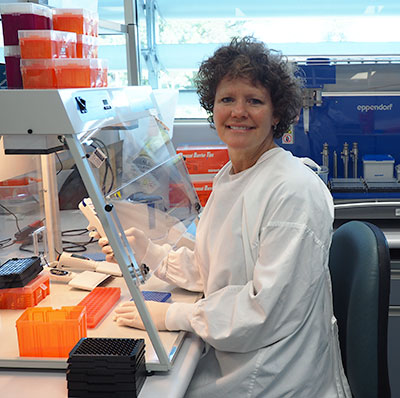The “shock and kill” approach to eradicating HIV from dormant cell reservoirs is a very active area of HIV research. In these monthly updates, we’ve discussed several drugs, developed to treat a variety of diseases, including cancer and epilepsy, that have the capacity to reverse such a latent state in the test tube. But whether these drugs are potent enough to cause a decrease in the HIV reservoir in HIV-infected individuals remains uncertain. Persistent reservoirs of virus not cleared by antiretroviral therapy (ART) represent the main barrier to a cure. In September, two separate teams of amfAR-funded investigators outlined their strategies to address this issue.
 Dr. Sarah PalmerDr. Sarah Palmer from the University of Sydney, together with colleagues from the University of Melbourne, Monash University, and Macquarie University in Australia, Aarhus University Hospital in Denmark, Leidos Biomedical Research Inc. in Maryland, Harvard University, and the U.S. National Cancer Institute examined the nature of HIV stimulated by two of the first latency reversing agents (LRAs) used clinically: panobinostat and vorinostat, which are both cancer medicines. Writing in Nature Communications, the researchers described how they sequenced viruses from 29 people living with HIV with undetectable viral loads on ART for 2.5 to 16 years. Each was given one of these drugs.
Dr. Sarah PalmerDr. Sarah Palmer from the University of Sydney, together with colleagues from the University of Melbourne, Monash University, and Macquarie University in Australia, Aarhus University Hospital in Denmark, Leidos Biomedical Research Inc. in Maryland, Harvard University, and the U.S. National Cancer Institute examined the nature of HIV stimulated by two of the first latency reversing agents (LRAs) used clinically: panobinostat and vorinostat, which are both cancer medicines. Writing in Nature Communications, the researchers described how they sequenced viruses from 29 people living with HIV with undetectable viral loads on ART for 2.5 to 16 years. Each was given one of these drugs.
Palmer and associates discovered that the HIV RNA sequences detected came from a very broad range of formerly latent viruses. This was good news, as before this study it was unclear whether the reversal of HIV latency by LRAs reflected activation of only a subset of viruses, or if the agents were more broadly acting.
They also discovered that the viral sequences recovered contained a large percentage of defective viruses incapable of killing cells. However, their presence—intermixed with viruses that are fully capable of replicating—confounds measures of the true effectiveness of these viral eradication strategies. As the authors concluded, such a high percentage of defective viruses “emphasizes the importance of developing cost-effective sensitive assays that measure” such viruses, which represents the Record (R) part of amfAR’s C.U.R.E. strategy .
 Dr. Marta MassanellaDr. Marta Massanella from the University of California at San Diego, with colleagues from the University of Barcelona, took another approach to developing LRAs. Rather than testing drugs, they looked at vaccines. It has long been known that common vaccines can cause viral “blips,” or transient increases in virus among HIV-infected individuals, regardless of their use of ART. Writing in the September issue of AIDS, these researchers reported on 26 such individuals on ART who received a combined flu or pneumococcal vaccine with a hepatitis B vaccination, or a placebo. Increases in activated T cells, paralleled by increases in markers of HIV activation as well as enhanced immune responses against HIV, were noted.
Dr. Marta MassanellaDr. Marta Massanella from the University of California at San Diego, with colleagues from the University of Barcelona, took another approach to developing LRAs. Rather than testing drugs, they looked at vaccines. It has long been known that common vaccines can cause viral “blips,” or transient increases in virus among HIV-infected individuals, regardless of their use of ART. Writing in the September issue of AIDS, these researchers reported on 26 such individuals on ART who received a combined flu or pneumococcal vaccine with a hepatitis B vaccination, or a placebo. Increases in activated T cells, paralleled by increases in markers of HIV activation as well as enhanced immune responses against HIV, were noted.
The mechanism behind these effects has not yet been assessed. But given these promising findings, the authors concluded that such immune stimulatory methods “might be a useful adjuvant as part of a combination or tiered approach to HIV-1 eradication.”
Dr. Laurence is amfAR’s senior scientific consultant.